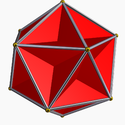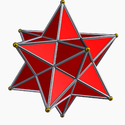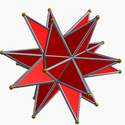
Schläfli-Hess polychoron
Encyclopedia

Geometry
Geometry arose as the field of knowledge dealing with spatial relationships. Geometry was one of the two fields of pre-modern mathematics, the other being the study of numbers ....
, Schläfli–Hess polychora are the complete set of 10 regular
Regular polytope
In mathematics, a regular polytope is a polytope whose symmetry is transitive on its flags, thus giving it the highest degree of symmetry. All its elements or j-faces — cells, faces and so on — are also transitive on the symmetries of the polytope, and are regular polytopes of...
self-intersecting star polychora (four-dimensional polytopes). They are named in honor of their discoverers: Ludwig Schläfli
Ludwig Schläfli
Ludwig Schläfli was a Swiss geometer and complex analyst who was one of the key figures in developing the notion of higher dimensional spaces. The concept of multidimensionality has since come to play a pivotal role in physics, and is a common element in science fiction...
and Edmund Hess
Edmund Hess
Edmund Hess was a German mathematician who discovered several regular polytopes.- References :* Regular Polytopes, , Dover edition, ISBN 0-486-61480-8...
. Each is represented by a Schläfli symbol {p,q,r} in which one of the numbers is 5/2
Pentagram
A pentagram is the shape of a five-pointed star drawn with five straight strokes...
. They are thus analogous to the regular nonconvex Kepler–Poinsot polyhedra.
Allowing for regular star polygons as cells
Cell (geometry)
In geometry, a cell is a three-dimensional element that is part of a higher-dimensional object.- In polytopes :A cell is a three-dimensional polyhedron element that is part of the boundary of a higher-dimensional polytope, such as a polychoron or honeycomb For example, a cubic honeycomb is made...
and vertex figure
Vertex figure
In geometry a vertex figure is, broadly speaking, the figure exposed when a corner of a polyhedron or polytope is sliced off.-Definitions - theme and variations:...
s, these 10 polychora add to the set of six regular convex 4-polytopes. All may be derived as stellation
Stellation
Stellation is a process of constructing new polygons , new polyhedra in three dimensions, or, in general, new polytopes in n dimensions. The process consists of extending elements such as edges or face planes, usually in a symmetrical way, until they meet each other again...
s of the 120-cell {5,3,3} or the 600-cell {3,3,5}.
History
Four of them were found by Ludwig SchläfliLudwig Schläfli
Ludwig Schläfli was a Swiss geometer and complex analyst who was one of the key figures in developing the notion of higher dimensional spaces. The concept of multidimensionality has since come to play a pivotal role in physics, and is a common element in science fiction...
while the other six were skipped because he would not allow forms that failed the Euler characteristic
Euler characteristic
In mathematics, and more specifically in algebraic topology and polyhedral combinatorics, the Euler characteristic is a topological invariant, a number that describes a topological space's shape or structure regardless of the way it is bent...
on cells or vertex figures (for zero-hole tori: F − E + V = 2). That excludes cells and vertex figures as {5,5/2}, and {5/2,5}.
Edmund Hess
Edmund Hess
Edmund Hess was a German mathematician who discovered several regular polytopes.- References :* Regular Polytopes, , Dover edition, ISBN 0-486-61480-8...
(1843–1903) published the complete list in his 1883 German book Einleitung in die Lehre von der Kugelteilung mit besonderer Berücksichtigung ihrer Anwendung auf die Theorie der Gleichflächigen und der gleicheckigen Polyeder.
Names
Their names given here were given by John ConwayJohn Horton Conway
John Horton Conway is a prolific mathematician active in the theory of finite groups, knot theory, number theory, combinatorial game theory and coding theory...
, extending Cayley's
Arthur Cayley
Arthur Cayley F.R.S. was a British mathematician. He helped found the modern British school of pure mathematics....
names for the Kepler–Poinsot polyhedra: along with stellated and great, he adds a grand modifier. Conway offered these operational definitions:
- stellationStellationStellation is a process of constructing new polygons , new polyhedra in three dimensions, or, in general, new polytopes in n dimensions. The process consists of extending elements such as edges or face planes, usually in a symmetrical way, until they meet each other again...
– replaces edges by longer edges in same lines. (Example: a pentagonPentagonIn geometry, a pentagon is any five-sided polygon. A pentagon may be simple or self-intersecting. The sum of the internal angles in a simple pentagon is 540°. A pentagram is an example of a self-intersecting pentagon.- Regular pentagons :In a regular pentagon, all sides are equal in length and...
stellates into a pentagramPentagramA pentagram is the shape of a five-pointed star drawn with five straight strokes...
) - greatening – replaces the faces by large ones in same planes. (Example: an icosahedronIcosahedronIn geometry, an icosahedron is a regular polyhedron with 20 identical equilateral triangular faces, 30 edges and 12 vertices. It is one of the five Platonic solids....
greatens into a great icosahedron) - aggrandizement – replaces the cells by large ones in same 3-spaces.
Symmetry
All ten polychora have [3,3,5] (H4) hexacosichoric symmetry. They are generated from 6 related rational-order symmetry groupsGoursat tetrahedron
In geometry, a Goursat tetrahedron is a tetrahedral fundamental domain of a Wythoff construction. Each tetrahedral face represents a reflection hyperplane on 3-dimensional surfaces: the 3-sphere, the Euclidean 3-space, and hyperbolic 3-space. Coxeter named after Edouard Goursat who first looked...
: [3,5,5/2], [5,5/2,5], [5,3,5/2], [5/2,5,5/2], [5,5/2,3], [3,3,5/2].
Each group has 2 regular star-polychora, except for two groups which are self-dual, having only one. So there are 4 dual-pairs and 2 self-dual forms among the ten regular star polychora.
Table of elements
Note:- There are 2 unique vertex arrangementVertex arrangementIn geometry, a vertex arrangement is a set of points in space described by their relative positions. They can be described by their use in polytopes....
s, matching those of the 120-cell and 600-cell. - There are 4 unique edge arrangements, which are shown as wireframes orthographic projectionsOrthographic projection (geometry)In Euclidean geometry, an orthographic projection is an orthogonal projection. In particular, in 3D it is an affine, parallel projection of an object onto a perpendicular plane....
. - There are 7 unique face arrangements, shown as solids (face-colored) orthographic projections.
The cells (polyhedra), their faces (polygons), the polygonal edge figures and polyhedral vertex figure
Vertex figure
In geometry a vertex figure is, broadly speaking, the figure exposed when a corner of a polyhedron or polytope is sliced off.-Definitions - theme and variations:...
s are identified by their Schläfli symbols.
| Name |
Wireframe | Solid | Schläfli {p, q,r} Coxeter–Dynkin |
Cells {p, q} |
Faces {p} |
Edges {r} |
Vertices {q, r} |
Density Polytope density In geometry, polytope density represents the number of windings of a polytope, particularly a uniform or regular polytope, around its center. It can be visually determined by counting the minimum number of facet crossings of a ray from the center to infinity... |
χ Euler characteristic In mathematics, and more specifically in algebraic topology and polyhedral combinatorics, the Euler characteristic is a topological invariant, a number that describes a topological space's shape or structure regardless of the way it is bent... |
Dual {r, q,p} |
|---|---|---|---|---|---|---|---|---|---|---|
| Icosahedral 120-cell |  |
 |
{3,5,5/2} |
120 {3,5} Icosahedron In geometry, an icosahedron is a regular polyhedron with 20 identical equilateral triangular faces, 30 edges and 12 vertices. It is one of the five Platonic solids....  |
1200 {3} Triangle A triangle is one of the basic shapes of geometry: a polygon with three corners or vertices and three sides or edges which are line segments. A triangle with vertices A, B, and C is denoted ....  |
720 {5/2} Pentagram A pentagram is the shape of a five-pointed star drawn with five straight strokes...  |
120 {5,5/2}  |
4 | 480 | Small stellated 120-cell |
| Small stellated 120-cell |  |
 |
{5/2,5,3} |
120 {5/2,5}  |
720 {5/2} Pentagram A pentagram is the shape of a five-pointed star drawn with five straight strokes...  |
1200 {3} Triangle A triangle is one of the basic shapes of geometry: a polygon with three corners or vertices and three sides or edges which are line segments. A triangle with vertices A, B, and C is denoted ....  |
120 {5,3}  |
4 | −480 | Icosahedral 120-cell |
| Great 120-cell |  |
 |
{5,5/2,5} |
120 {5,5/2}  |
720 {5} Pentagon In geometry, a pentagon is any five-sided polygon. A pentagon may be simple or self-intersecting. The sum of the internal angles in a simple pentagon is 540°. A pentagram is an example of a self-intersecting pentagon.- Regular pentagons :In a regular pentagon, all sides are equal in length and...  |
720 {5} Pentagon In geometry, a pentagon is any five-sided polygon. A pentagon may be simple or self-intersecting. The sum of the internal angles in a simple pentagon is 540°. A pentagram is an example of a self-intersecting pentagon.- Regular pentagons :In a regular pentagon, all sides are equal in length and...  |
120 {5/2,5}  |
6 | 0 | Self-dual |
| Grand 120-cell |  |
 |
{5,3,5/2} |
120 {5,3}  |
720 {5} Pentagon In geometry, a pentagon is any five-sided polygon. A pentagon may be simple or self-intersecting. The sum of the internal angles in a simple pentagon is 540°. A pentagram is an example of a self-intersecting pentagon.- Regular pentagons :In a regular pentagon, all sides are equal in length and...  |
720 {5/2} Pentagram A pentagram is the shape of a five-pointed star drawn with five straight strokes...  |
120 {3,5/2}  |
20 | 0 | Great stellated 120-cell |
| Great stellated 120-cell |  |
 |
{5/2,3,5} |
120 {5/2,3}  |
720 {5/2} Pentagram A pentagram is the shape of a five-pointed star drawn with five straight strokes...  |
720 {5} Pentagon In geometry, a pentagon is any five-sided polygon. A pentagon may be simple or self-intersecting. The sum of the internal angles in a simple pentagon is 540°. A pentagram is an example of a self-intersecting pentagon.- Regular pentagons :In a regular pentagon, all sides are equal in length and...  |
120 {3,5} Icosahedron In geometry, an icosahedron is a regular polyhedron with 20 identical equilateral triangular faces, 30 edges and 12 vertices. It is one of the five Platonic solids....  |
20 | 0 | Grand 120-cell |
| Grand stellated 120-cell |  |
 |
{5/2,5,5/2} |
120 {5/2,5}  |
720 {5/2} Pentagram A pentagram is the shape of a five-pointed star drawn with five straight strokes...  |
720 {5/2} Pentagram A pentagram is the shape of a five-pointed star drawn with five straight strokes...  |
120 {5,5/2}  |
66 | 0 | Self-dual |
| Great grand 120-cell |  |
 |
{5,5/2,3} |
120 {5,5/2}  |
720 {5} Pentagon In geometry, a pentagon is any five-sided polygon. A pentagon may be simple or self-intersecting. The sum of the internal angles in a simple pentagon is 540°. A pentagram is an example of a self-intersecting pentagon.- Regular pentagons :In a regular pentagon, all sides are equal in length and...  |
1200 {3} Triangle A triangle is one of the basic shapes of geometry: a polygon with three corners or vertices and three sides or edges which are line segments. A triangle with vertices A, B, and C is denoted ....  |
120 {5/2,3}  |
76 | −480 | Great icosahedral 120-cell |
| Great icosahedral 120-cell |  |
 |
{3,5/2,5} |
120 {3,5/2}  |
1200 {3} Triangle A triangle is one of the basic shapes of geometry: a polygon with three corners or vertices and three sides or edges which are line segments. A triangle with vertices A, B, and C is denoted ....  |
720 {5} Pentagon In geometry, a pentagon is any five-sided polygon. A pentagon may be simple or self-intersecting. The sum of the internal angles in a simple pentagon is 540°. A pentagram is an example of a self-intersecting pentagon.- Regular pentagons :In a regular pentagon, all sides are equal in length and...  |
120 {5/2,5}  |
76 | 480 | Great grand 120-cell |
| Grand 600-cell |  |
 |
{3,3,5/2} |
600 {3,3} Tetrahedron In geometry, a tetrahedron is a polyhedron composed of four triangular faces, three of which meet at each vertex. A regular tetrahedron is one in which the four triangles are regular, or "equilateral", and is one of the Platonic solids...  |
1200 {3} Triangle A triangle is one of the basic shapes of geometry: a polygon with three corners or vertices and three sides or edges which are line segments. A triangle with vertices A, B, and C is denoted ....  |
720 {5/2} Pentagram A pentagram is the shape of a five-pointed star drawn with five straight strokes...  |
120 {3,5/2}  |
191 | 0 | Great grand stellated 120-cell |
| Great grand stellated 120-cell |  |
 |
{5/2,3,3} |
120 {5/2,3}  |
720 {5/2} Pentagram A pentagram is the shape of a five-pointed star drawn with five straight strokes...  |
1200 {3} Triangle A triangle is one of the basic shapes of geometry: a polygon with three corners or vertices and three sides or edges which are line segments. A triangle with vertices A, B, and C is denoted ....  |
600 {3,3} Tetrahedron In geometry, a tetrahedron is a polyhedron composed of four triangular faces, three of which meet at each vertex. A regular tetrahedron is one in which the four triangles are regular, or "equilateral", and is one of the Platonic solids...  |
191 | 0 | Grand 600-cell |
Existence
The existence of a regular polychoron is constrained by the existence of the regular polyhedra
is constrained by the existence of the regular polyhedra  and a dihedral angle
and a dihedral angleDihedral angle
In geometry, a dihedral or torsion angle is the angle between two planes.The dihedral angle of two planes can be seen by looking at the planes "edge on", i.e., along their line of intersection...
constraint:
The six regular convex polytopes and 10 star polytopes above are the only solutions to these constraints.
There are four nonconvex Schläfli symbols {p,q,r} that have valid cells {p,q} and vertex figures {q,r}, and pass the dihedral test, but fail to produce finite figures: {3,5/2,3}, {4,3,5/2}, {5/2,3,4}, {5/2,3,5/2}.
See also
- List of regular polytopes
- Convex regular 4-polytopeConvex regular 4-polytopeIn mathematics, a convex regular 4-polytope is a 4-dimensional polytope that is both regular and convex. These are the four-dimensional analogs of the Platonic solids and the regular polygons ....
– Set of convex regular polychoron - Kepler-Poinsot polyhedra – regular star polyhedronStar polyhedronIn geometry, a star polyhedron is a polyhedron which has some repetitive quality of nonconvexity giving it a star-like visual quality.There are two general kinds of star polyhedron:*Polyhedra which self-intersect in a repetitive way....
- Star polygon – regular star polygons
External links
-
- Jonathan Bowers, 16 regular polychora
- Discussion on names
- Reguläre Polytope
- The Regular Star Polychora
- Stella4D Stella (software)Stella (software)Stella, a computer program available in three versions was created by Robert Webb of Australia...
produces interactive views of all 1849 known uniform polychora including the 64 convex forms and the infinite prismatic families. Was used to create images for this page.


